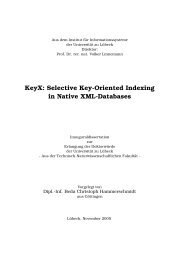Gesture-Based Interaction with Time-of-Flight Cameras
Gesture-Based Interaction with Time-of-Flight Cameras
Gesture-Based Interaction with Time-of-Flight Cameras
Create successful ePaper yourself
Turn your PDF publications into a flip-book with our unique Google optimized e-Paper software.
allow arbitrary range maps to be used, but they are all somewhat ad-hoc.<br />
4.2. METHOD<br />
Our approach to improving the accuracy <strong>of</strong> the range map using the shading con-<br />
straint is based on a probabilistic model <strong>of</strong> the image formation process. We obtain<br />
a maximum a posteriori estimate for the range map using a numerical minimiza-<br />
tion technique. The approach has a solid theoretical foundation and incorporates<br />
the sensor-based range information and the shading constraint in a single model;<br />
for details, see Section 4.2. The method delivers robust estimation results on both<br />
synthetic and natural images, as we show in Section 4.3.<br />
4.2 Method<br />
4.2.1 Probabilistic Image Formation Model<br />
We seek to find the range map R that maximizes the posterior probability<br />
p(X R , X I |R, A) p(R) p(A).<br />
✞ ☎<br />
✝4.1<br />
✆<br />
p(X R , X I |R, A) is the probability <strong>of</strong> observing a range map X R and an intensity image<br />
X I given that the true range map describing the shape <strong>of</strong> the imaged object is R and<br />
that the parameters <strong>of</strong> the reflectance model are A. Typically, A is the albedo <strong>of</strong> the<br />
object – we will discuss this in more detail below. p(R) is a prior on the range map,<br />
p(A) is a prior on the reflectance model parameters.<br />
The conditional probability p(X R , X I |R, A) is based on the following model <strong>of</strong><br />
image formation: First <strong>of</strong> all, we assume that p(X R , X I |R, A) can be written as fol-<br />
lows:<br />
p(X R , X I |R, A) = p(X R |R, A) p(X I |R, A).<br />
✞ ☎<br />
✝4.2<br />
✆<br />
In other words, the observations X R and X I are conditionally independent given R<br />
and A.<br />
We now assume that the observed range map X R is simply the true range map R<br />
<strong>with</strong> additive Gaussian noise, i.e.<br />
p(X R |R, A) = N (X R − R|µ = 0, σR(R, A)).<br />
✞ ☎<br />
✝4.3<br />
✆<br />
Note that the standard deviation σR is not constant but can vary per pixel as a func-<br />
tion <strong>of</strong> range and albedo. As we will see in Section 4.2.4, the noise in the range mea-<br />
surement <strong>of</strong> a TOF camera depends on the amount <strong>of</strong> light that returns to the camera.<br />
The shading constraint postulates that a given range map R is associated <strong>with</strong><br />
35

















